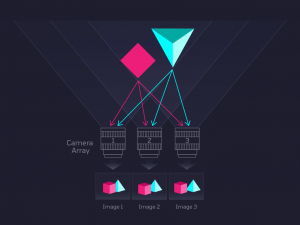What is Light Field Imaging
A photographic camera captures the radiant intensity of light in a plane. A light field camera captures the entire light field in a plane. The light field consists of the radiant intensity and the direction of the light. Thus, if you know the radiant intensity and direction of the light in one plane, you can also calculate the intensity and direction of this light in other planes.
This principle enables light field cameras to reconstruct the 3D information of a scene or to refocus the image onto other planes. These advantages come with one drawback: the resulting image from a light field sensor has less resolution compared to the resolution of the photo image sensor.
On the right: Shows the Working Principle of an ordinary light field camera. A camera array captures a scene from different angles, and thus the intensity and position of the light and the direction of the light is recorded.

Why Light Field HSI is such a great idea
A typical light field camera utilizes a microlens array in front of a conventional image sensor. The microlens array generates a multitude of similar images onto the sensor (the same principle as an insect’s eye). From the slight angle differences between each image, the direction of the light can be calculated. Since each image is in part redundant, this step decreases the resolution of the system.
However, in hyperspectral light field imaging, we use this step to introduce another measurement dimension to the camera: the wavelength. In our systems, every single image records a slightly different wavelength of the scene while conserving all other positive aspects of the light field.
Each sensor readout holds the following multidimensional dataset:
- Wavelength and Intensity (e.g.: 350-1000 nm)
- Position X, Y (e.g.: 410px x 410px)
- Distance Z*
- Incident Angle*
On the right: Working Principle of a hyperspectral light field camera. The camera array captures a scene from different angles. Thus, the wavelength and radiant intensity, as well as the position and direction of the light, is captured.


The complete dataset is captured within milliseconds and can be read out with video frame rates.
Instead of losing sensor pixels (as with light field cameras) we transform this sensor data into the wavelength dimension. Thus, the cameras do not lose the resolution of the underlying sensor. The resolution of each band can be chosen by the simple formulation:
spatial resolution = chip resolution / # of bands.
This setup is highly adaptable and, in addition to our off-the-shelf products, we offer solutions with customizable specifications to match your requirements.
On the left: Hyperspectral light field cameras are highly adaptable and the resolution of each band can be chosen by dividing the sensor resolution with the # of desired bands.
Why Light Field HSI offers superior quality
The core working principle of every spectrometer is its wavelength specificity. The quality and the characteristics of the whole system are determined to a significant degree by this element. For good spectral separation, this element should be chosen to have the highest quality possible.
However, for some snapshot spectral imaging technologies, this element must be limited so other goals can be achieved. Filter-on-chip technologies, for example, can only use simple spectral filters to achieve the goal of maximum miniaturization.
The light field approach, on the other hand, enables the use of filters with the highest quality in terms of transmission, blockage and crosstalk reduction. This is mainly due to the fact that we, in comparison with filter on chip approaches can use highly reliable optical thin film filters which achieve these superior specifications due to the application of 50-150 coating layers.
On the right: Filter specifications of the Ultris X20. The filters have a transmission >90% and feature a blocking of OD4*. The resulting spectra are equidistant and equally broad for every wavelength. *(OD4 equals 0.01% transmission in unwanted wavelength)

Why Light Field HSI offers superior reproducibility
The reproducibility of hyperspectral measurements plays an important role in the reliability of data analysis, especially when an application has to work on multiple systems at once.
The reproducibility of a system is mainly governed by its mechanical and thermal stability and the intrasystem reproducibility of a given filter set. For hyperspectral systems employing electrically tunable filters, electrical stability plays another important role.
Light field spectral imaging cameras possess some major advantages over their predecessors due to their construction. The devices are monolithic, with no moving parts, and thus offer extremely high mechanical stability. Due to the small building height and the physical properties of the filter set, the thermal stability is excellent.
The intrasystem stability was measured for a test set of 100 systems. The typical wavelength error is in the range of +/- 0.8 nm. For special applications, the filter sets can be preselected to achieve even higher accuracy.
On the right: Wavelength accuracy of a test set of 100 systems. The central wavelength error ranges between -0.8 to + 0.8 nm.

Light Field HSI in summary
In summary, light field hyperspectral imaging features some striking advantages. These devices offer a hyperspectral snapshot datacube with high spatial resolution. The light throughput is very high and the filter quality is superior. Due to the physical and mechanical properties, the devices offer very high reproducibility. With further data analysis, even 3D reconstruction is possible with the devices.
Light field hyperspectral imaging advantages:
- Snapshot with a high light throughput
- High spatial resolution
- Very high filter quality
- Very low crosstalk (OD4 blockage)
- Stationary setup – no moving parts
- Very good intrasystem reproducibility
We offer a very deep look into our internal testing in our upcoming blog. Please refer to this section to learn more about these properties.
